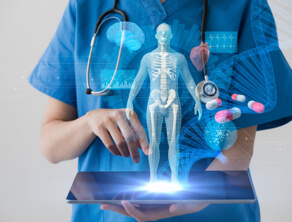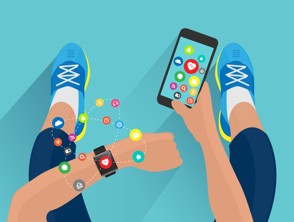IoT Medical Devices and the Internet of Medical Things.

In the ever-evolving landscape of modern healthcare, technology redefines what is possible. One of the most remarkable advancements that has taken the medical field by storm is the integration of the Internet of Things (IoT) into medical devices.
This convergence has given rise to a new era of patient care, where data-driven insights and real-time monitoring are transforming how we diagnose, treat, and manage health conditions.
The marriage of IoT and healthcare has opened doors to many possibilities, enabling medical professionals to monitor patients remotely, collect vital health data, and make informed decisions like never before.
IoT in healthcare refers to integrating Internet of Things (IoT) technologies and devices within the healthcare industry to enhance patient care, streamline processes, improve diagnostics, and enable remote monitoring.
This interconnected ecosystem of medical devices, wearables, sensors, and software applications leverages data exchange and real-time communication to transform healthcare delivery and decision-making.
IoT in healthcare has revolutionized how medical services are provided, creating a new era of personalized and data-driven patient care.
This blog explores IoT’s transformative impact on healthcare, spotlighting how IoT medical devices are reshaping the industry’s landscape.
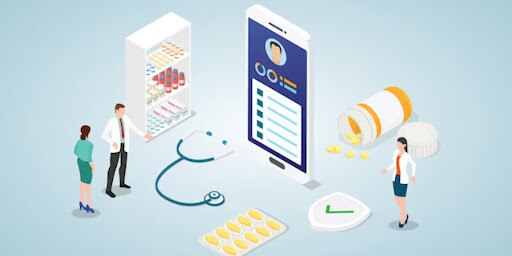
Understanding the Internet of Medical Things (IoMT)
The Internet of Medical Things refers to the network of interconnected medical devices, equipment, sensors, and software applications that collect, transmit, and exchange health-related data over the Internet.
These devices range from wearable fitness trackers to advanced hospital medical equipment. By seamlessly integrating these devices into healthcare systems, IoMT aims to improve patient monitoring, diagnosis, treatment, and overall healthcare delivery.
The Future of IoMT: As technology advances, the IoMT landscape is poised for significant growth. Anticipated developments include:
- AI and Machine Learning Integration: Integrating artificial intelligence and machine learning will enable more accurate diagnoses, personalized treatment recommendations, and predictive healthcare analytics.
- Telemedicine Expansion: IoMT will further drive the growth of telemedicine, enabling patients to access quality healthcare remotely.
- Wearable Innovations: Wearable IoT devices will become more sophisticated, allowing for continuous health monitoring and early detection of health issues.
- Smart Healthcare Facilities: Hospitals and clinics will adopt IoT-enabled systems for improved patient care, asset management, and operational efficiency.
IoT Medical Devices: Transforming Healthcare
The IoT Revolution in Healthcare: The Internet of Things (IoT) refers to the interconnected network of devices, objects, and sensors that can communicate and exchange data over the Internet.
This technology has entered the healthcare sector, giving rise to a new era of intelligent and connected medical devices. IoT medical devices leverage this connectivity to collect, transmit, and analyze real-time patient data, leading to more informed medical decisions and personalized treatment plans.
Enhanced Patient Monitoring and Care: IoT medical devices enable continuous and remote patient monitoring, allowing healthcare professionals to track vital signs, medication adherence, and other critical health metrics closely.
Patients can use wearable IoT devices, such as smartwatches and health trackers, which monitor their heart rate, blood pressure, glucose levels, and more. This real-time data empowers doctors to intervene promptly in emergencies or deviations from the patient’s baseline health, leading to early detection and preventing complications.
Improved Diagnostics and Treatment: Integrating IoT technology in medical devices has elevated the accuracy and efficiency of diagnostics. Devices like IoT-enabled imaging equipment provide high-resolution images that radiologists and specialists can instantly share and analyze, regardless of physical location. This real-time collaboration expedites the diagnostic process, making faster and more accurate treatment decisions.
Precision Medicine and Personalized Care: IoT medical devices are pivotal in advancing precision medicine. By continuously collecting patient data, these devices contribute to a comprehensive understanding of an individual’s health status.
This wealth of data enables healthcare providers to tailor treatment plans and interventions to each patient’s needs, maximizing treatment efficacy and minimizing adverse effects.
Streamlined Healthcare Systems: IoT medical devices extend their influence beyond patient care and directly impact the efficiency of healthcare systems. IoT-enabled inventory management systems help hospitals track medical supplies, ensuring timely restocking and reducing waste.
Additionally, predictive medical equipment maintenance through IoT sensors prevents unplanned downtime, minimizes disruptions in patient care, and optimizes resource allocation.
Challenges and Considerations: While integrating IoT medical devices offers substantial benefits, it also raises specific challenges. Data security and patient privacy are paramount, as the increased connectivity exposes sensitive medical information to potential cyber threats.
Robust encryption and stringent data protection measures are imperative to safeguard patient data and maintain trust in the healthcare ecosystem.
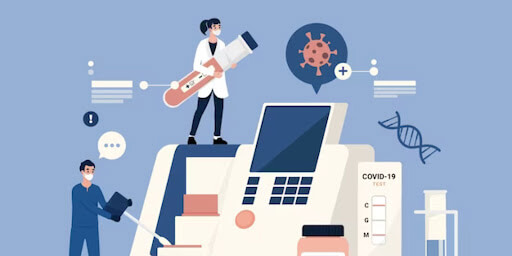
Applications of IoT in Healthcare
A. Remote Patient Monitoring and Management:
Among the applications of IoT in healthcare, we see real-time remote patient monitoring and management through wearable IoT medical devices. These devices collect and transmit vital signs, medication adherence, and other health-related data to healthcare providers.
This technology enables physicians to closely monitor patients with chronic conditions, post-operative patients, and the elderly, ensuring timely interventions and reducing hospital readmissions. IoT medical devices for remote monitoring optimize patient care and empower individuals to participate actively in their health management.
B. Telemedicine and Virtual Consultations:
IoMT has facilitated seamless telemedicine and virtual consultations by remotely connecting patients with healthcare professionals. IoT-enabled devices such as intelligent stethoscopes, digital otoscopes, and high-resolution cameras allow physicians to diagnose and treat patients without the concern for in-person visits.
This approach improves healthcare access, especially for remote or underserved individuals. Integrating IoT medical devices in telemedicine enhances patient convenience while maintaining the quality of medical care.
C. Predictive Analytics and Early Disease Detection:
IoT medical devices and predictive analytics are crucial in early disease detection and prevention. These devices continuously gather patient data, feeding it into sophisticated algorithms that can identify patterns indicative of potential health issues.
By analyzing historical and real-time data, healthcare providers can predict and prevent diseases before they escalate. This application of IoMT optimizes healthcare resources, reduces treatment costs, and improves patient outcomes.
D. Smart Hospital Infrastructure and Asset Tracking:
IoT-driven smart hospital infrastructure enhances operational efficiency and patient experience. IoT medical devices are utilized to monitor hospital equipment, track inventory levels of medical supplies, and manage the utilization of resources.
Real-time data from IoT devices enable hospital administrators to make informed decisions, ensuring the availability of critical assets when needed. This optimization leads to streamlined workflows, reduced waste, and improved healthcare facility patient care.
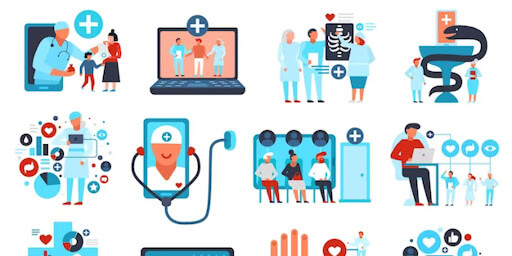
Future Trends and Developments
A. Evolving Role of AI and Machine Learning in IoMT:
The integration of Artificial Intelligence (AI) and Machine Learning (ML) in the Internet of Things (IoT) for healthcare is set to redefine diagnostics and treatment. AI-powered algorithms will analyze real-time patient data collected from IoT medical devices, enabling early disease detection and personalized treatment plans. This synergy will enhance data accuracy, leading to more effective patient care and streamlined operations.
B. Expansion of IoMT into Personalized Medicine:
IoT in healthcare is propelling the expansion of IoMT into personalized medicine. By constantly monitoring patients’ vital signs and health parameters through IoT medical devices, healthcare providers can tailor interventions to individual needs. This trend will revolutionize treatment strategies, ensuring precision medicine and improved patient outcomes.
C. Potential Impact on Healthcare Outcomes and Patient Experience:
IoT in healthcare holds immense potential to positively impact healthcare outcomes and patient experiences. Real-time data collection and analysis through IoT medical devices will enable proactive and preventive care, reducing hospital readmissions and emergency visits. Patients will have more control over their health, leading to a more satisfying and engaged healthcare journey.
Conclusion
In conclusion, the Internet of Medical Things (IoMT) stands as a transformative force within healthcare, showcasing the remarkable potential of IoT in medical devices. As interconnected technologies evolve, IoMT’s integration of intelligent machines, data analytics, and real-time monitoring is poised to revolutionize patient care, diagnosis, and treatment.
By fostering enhanced communication, efficiency, and precision in healthcare systems, IoMT holds the promise of ushering in a new era of personalized, data-driven medicine. The synergy between IoT and healthcare is undeniably shaping a future where interconnected devices contribute to more effective and accessible medical solutions, ultimately improving patient outcomes and the overall well-being of individuals worldwide.
Also Read: All You Need to Know about Healthcare Technology.
![Blog-[x]cube LABS](https://d6fiz9tmzg8gn.cloudfront.net/wp-content/uploads/2016/06/blog_banner.jpg)



